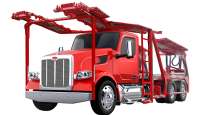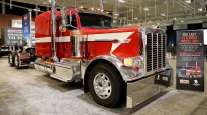Executive Editor
Peterbilt Unveils New Sleeper Design

SCOTTSDALE, Ariz. – Peterbilt Motors Co. has introduced a new sleeper design that offers improved aerodynamics, is available in single-and double-bunk designs, and was designed with input from drivers, the company said here.
The Peterbilt Model 579 UltraLoft features an 80-inch integrated sleeper that returns a 2% improvement in aerodynamics over the company’s current detachable sleeper, said Peterbilt chief engineer Scott Newhouse in an interview with Transport Topics. Newhouse and other Peterbilt executives were on hand at a Feb. 15 press event here to unveil the new sleeper.
Several design features contribute to those gains, including the windshield visor, which has an air foil design, and 18-inch extenders on each side of the sleeper to guide air along the side of the truck, said Wesley Slavin, Peterbilt’s marketing manager for on-highway products. These aerodynamic improvements also help reduce cabin noise, Newhouse noted.
RELATED: Peterbuilt plans to craft strategy to match customer demand
Inside, the sleeper’s design was aided by input from drivers, said Peterbilt general manager Kyle Quinn. “We worked with them on what did work and what didn’t work,” he said during a presentation. “We listened to our customers.”

Bunks inside the new Peterbilt sleeper by Joe Howard/Transport Topics.
Quinn told TT that the company employed “human-centered design” to glean input from drivers. This four-step process allowed Peterbilt to watch people use their products, then take what it learned to brainstorm ideas. From there, it built prototypes and then showed those prototypes to users to gather reactions. Quinn said Peterbilt has been using this process since about 2010, and noted that it is becoming a more common method of development for businesses.
“A lot of companies today are using various forms of what would be referred to as human-centered design,” he said. “The whole idea is to understand your user.”
Newhouse told TT that Peterbilt worked with its customer council to bring in drivers that could test various features during development.
“As they saw things, they would tell us, and we would make modifications,” he said. “They ultimately became the designers.”
From this work, Peterbilt placed a priority on including multiple and easily accessible power outlets in the UltraLoft so drivers can keep their electronic devices charged up. There are 12-volt, 110-volt and USB ports available on a panel on the driver’s side of the lower bunk, and this panel is duplicated on the upper bunk in double-bunk models, Newhouse said.
And those bunks can accommodate many drivers; the mattress on the bottom bunk is 85 inches in length, long enough for a seven foot tall individual, he said. The upper bunk has an 82-inch mattress. The UltraLoft also features a new HVAC system that increases air flow in the upper and lower bunks, and a foldaway ladder to help with accessing the upper bunk, Newhouse said.
Slavin added that storage bins above the driver and passenger doors are new with the UltraLoft. He noted that the sleeper also has a closet with 42 inches of hanging space to accommodate larger shirts, and an upper shelf in dual-bunk models that can hold two CPAP machines for drivers with sleep apnea.
The UltraLoft is available for ordering now, and production is slated to begin this summer, Peterbilt said.





